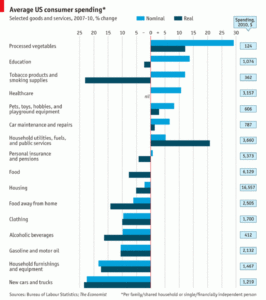Consumer spending is, without a doubt, one of the backbones of American culture. In the United States, it’s often impossible to go even one day without buying something, whether it’s purchasing a simple pack of gum or dropping some serious cash on a brand-new car. With these everyday, but vital, contributors to the United States’ economy in mind, it’s no wonder that consumer spending is one of the most important economic indicators for the U.S., accounting for about two-thirds of the U.S. economy. More specifically, retail sales (often the most common picture of consumerism) cover 40 percent of consumer spending. Given the seasonal nature of retail, sales reports are released on a monthly basis to be compared to that same month of a previous year. So yes, one could say that the holiday season and exchanging presents are not just about good will to all, considering sales made during that time are an especially strong indicator of how well (or how poorly) the U.S. economy is doing.
Additionally, it is important to note that, naturally, retail sales directly reflect consumers’ wealth and confidence in the economy. The more household incomes increase and stock prices rise, the wealthier people feel, which inclines them to spend more. If consumers are economically insecure about the future, they will spend less. To best illustrate this concept, let’s briefly look at consumer spending before and during the Great Recession of 2008.
On Oct. 25, 2011, The Economist published an article titled “Hard times: How the economic slowdown has changed consumer spending in America.” Given the year, 2011, the piece was written as the United States was attempting to climb from the depths of the crash that began in 2008, and the above graph depicts how resulting consumer spending changed between 2007 and 2010.
Personally, I was still in late elementary school when the crash occurred, and I distinctly remember that the recession did not hit my family hard until 2011 when my father was laid off from his full time job. As the graph communicates, the recession led to an overall decrease in consumer spending by the nation, and I definitely remember that my family had to reduce our spending, too. Now that I’m studying the topic years later with a more mature perspective, it’s interesting to see how my family’s decreased spending habits at the time reflected those of the nation as a whole, which is something my 11-year-old self could not process.
Most notably, the article points out how consumer spending had changed at large, writing, “Between 2007 and 2010, average annual consumer spending per unit—defined as a family/shared household or single/financially independent person—fell by 3.1% to $48,109. Average prices over this period have risen by 5.2%, so real consumer spending has fallen by almost 8%.” The article then compares these spending habits to those of the “peak years” of 2003-2006, stating that consumer spending actually rose by 8.2 percent during that time. Consequently, recession years brought less spending on luxuries like sugar and nicotine, whereas the earlier prosperous years saw an increase in spending on non-necessities, namely household goods and alcohol, by 13 percent and 19 percent, respectively.
Simply put, as depicted by this short sliver of time that had such a drastic, historic impact on the U.S. economy, when consumers aren’t spending, it’s not because they’ve lost interest in American consumerism; rather, decreased consumer spending indicates a much larger problem within the grander economic landscape. After all, America is nothing without its consumer goods, so a thriving economy is the best way to keep America and it’s (morally conflicting) consumerist values alive and well.
SOURCES:
https://www.economist.com/graphic-detail/2011/10/25/hard-times
Greg IP. The Little Book of Economics
Terri Thompson. Writing About Business

Leave a Reply
You must be logged in to post a comment.